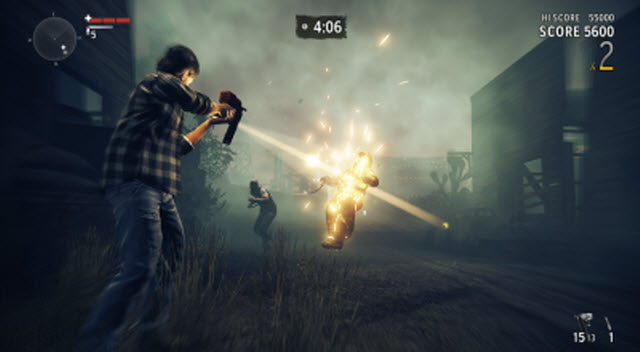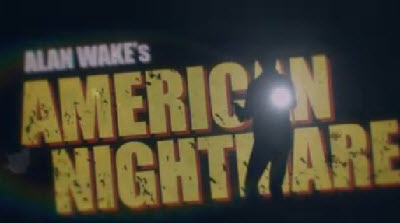Arcade mode
The pick-up-and play arcade mode is entertaining, but in a completely different way. This was the part of the game that Remedy’s designers started creating first in an effort to generate some really cool game play.
In the “Fight till Dawn” mode, your goal is to survive for 10 minutes as wave after wave of enemy comes after you. At first, just a couple of easy enemies come after you. You can collect some much-needed ammo — flares, flash bangs, and guns such as revolvers or shotguns — and then you just start running and gunning.
To survive, you have to keep your wits about you as you fight nonstop, much like you do in a Left4Dead zombie-killing combat session. The Taken enemies move fast to intercept you as you hunt the fields for ammo. You can reload your flashlight batteries and ammo at a designated supply box. But you can only use that a couple of times during the 10 minutes. At any given moment, several Taken will attack you from different directions.
You can hit the left bumper to dodge, or hit the right bumper to drop a flare or flash bang to make all of the enemies around you either vaporize or pull back. It takes you several shots to dispatch the Taken after you stun them (and drive out their protective darkness) with a flashlight. One of the best new additions to the weaponry is a nail gun, which spits out nails that stick into the Taken creatures as if they were fired from a machine gun. But if you want to do more damage, you can wield an Uzi submachine gun or a shotgun. The action is fast and furious. You score points based on your survival time and kills. You can get score multipliers for surviving without getting hit.
It took me forever to survive the 10-minute round in the first Cemetery level. I finally figured out that I could play with my back to a light. And then I could face in one direction toward the entrance to a grave stone area and just pick off the attackers one-by-one. Whenever it got too crazy, I dropped a flash bag, fired a flare gun, or raised a flare. That made the enemies back off. I was sprinting for my life and watching the clock run down as I finally survived until the break of dawn.
In some ways, the story mode and arcade mode are linked. If you’ve found a lot of the missing manuscript pages from the story mode, you can open more of the weapon boxes that are strewn about the arcade maps. If you get really good at arcade mode, you can unlock Nightmare mode, where the waves of creatures spawn constantly. Here’s a link to a video of the arcade mode.
The writing for much of the script, particularly the manuscript pages, is good. The action is better. Mr. Scratch is a compelling villain. He is so annoying that by the end of the game, you really want to give it to him. The Alan Wake universe is structured in a way that new stories can be easily added as coherent and stand-alone episodes of Night Springs.
Listening to the radio is an entertaining distraction. Talk show callers discuss the issue of free will versus predestination.
Arcade mode is a true delight that, while single-player only, you can share with your friends to see who can get bragging rights. This game has glimpses of brilliance, and the original Alan Wake would have been a much better game if Remedy had applied all of these changes to the original.
Falling short
In some ways, the Remedy developers are damned if they do, damned if they don’t. I didn’t like the fact that I had to retread the same scenes three times in story mode before I could complete the story. The repeats are justified, since Wake is caught in this Groundhog Day-like repetitive time arc. But it would have been more transparent of Remedy to say that they didn’t have a huge budget for this game and so used some of the same scenes over and over again. To me, that amounts to lazy game design, much like our GamesBeat review editor Sebastian Haley pointed out with the recent Legend of Zelda game. Why didn’t Remedy just make nine different scenes, rather than three scenes that repeated themselves three times. Of course, it was far cheaper to make the game this way, and that’s reasonable considering that gamers are only paying 25 percent of the usual ticket price for this game.
 But the production felt like it cut corners. The characters don’t move when they’re talking. The quality of the cinematics is decidedly low budget. That matches the campy feel of the Night Springs episode, but once again it feels like Remedy is falling short with this story. The other problem with going back to the same scene three times is that, no matter how many enemies come at you, the horror isn’t as good. The shock and surprise of being attacked by an enemy the first time is far more emotionally impactful than the second time around.
But the production felt like it cut corners. The characters don’t move when they’re talking. The quality of the cinematics is decidedly low budget. That matches the campy feel of the Night Springs episode, but once again it feels like Remedy is falling short with this story. The other problem with going back to the same scene three times is that, no matter how many enemies come at you, the horror isn’t as good. The shock and surprise of being attacked by an enemy the first time is far more emotionally impactful than the second time around.
I like the moments when the cinematic action approaches the same quality as Naughty Dog’s Uncharted series on the PlayStation 3. But the game has many flaws, such as poor lip-synching on characters such as Emma or animation flubs such as when one character tries to give Wake a passcode. The female characters are downright silly and overly sexy, under the influence of Mr. Scratch.
One of the best characters of the first game, Wake’s agent Barry, barely appears in this version. That is a mistake, since Barry provided the much-needed comic relief to the pulp fiction drama. The supernatural Mr. Scratch is just a little too creepy to be funny. Meanwhile, you run into these flawed characters not once, but three times.
What we get instead of more Barry is a new set of enemies: spiders. These spiders can be cooked with light or shot in the dark with a gun. They are so wimpy that they’re not very scary. I’d much rather have an actual confrontation with Mr. Scratch as he’s holding some victim hostage, rather than shoot at spiders.
That could be forgiven if the major battles of the story mode game were a little more like big set pieces, where the action takes place on some kind of absolutely crazy level that you find in the arcade mode. But while those battles are desperate and fierce, nothing that happens in them is stunning or surprising. The last battle is entirely predictable.
Conclusion
Remedy has succeeded in challenging the conventions of what makes an Xbox Live Arcade game. Once again, the writing is really good and the manuscript pages are a pleasure to hear as the Wake character narrates them. The voice acting is excellent. The heavy metal songs that play during the action scenes are apt. Among them is a new single from the fictionl Old Gods of Asgard band. Once in a while you feel like you are moving through a dream, rather than a video game.
But Remedy didn’t entirely succeed in making both the story and arcade modes equally fun. I actually enjoyed arcade mode much more than the story, and that is the main reason why users can have hours and hours of fun with this game. Let’s hope that the game does well enough to justify the publication of Alan Wake 2, and I certainly hope that game will be a full three-course meal, not just a good hamburger. Score: 82/100.
VentureBeat's mission is to be a digital town square for technical decision-makers to gain knowledge about transformative enterprise technology and transact. Learn More


